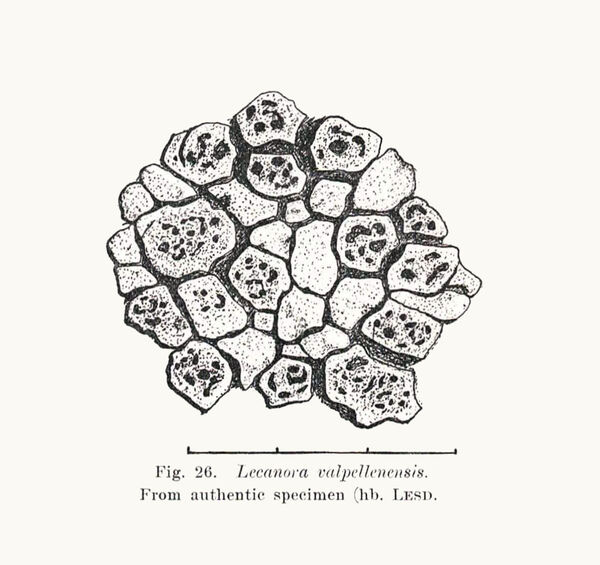Aspicilia valpellinensis B. de Lesd.
Bull. Soc. Bot. France, 59: 686, 1912.
Synonyms: Aspicilia cinerea var. chiodectonoides Anzi; Lecanora valpellinensis (B. de Lesd.) Zahlbr.
Distribution: N - Lomb, VA (Piervittori & Isocrono 1999).
Description: Thallus crustose, episubstratic, rimose-areolate, 0.2-0.5 mm thick, pale ash-grey, sometimes with a bluish tinge. Areoles 0.7-1(-1.5) mm wide, flat, angular, separated by narrow cracks, the fertile ones somewhat larger and sometimes slightly prominent. Cortex 25-35 µm thick, dark brown in upper part, colourless in lower part, overlain by a 15-20 µm thick epinecral layer; medulla white to ochraceous, I-; algal layer not extending below the hypothecium. Apothecia lecanorine-aspicilioid, immersed in the areoles, rarely solitary or 2-3, usually 5-15 per areole, punctiform to irregular in outline, 0.1-0.3 mm across, with a black disc and a thin, often indistinct thalline margin. Exciple 10-15 µm thick, I+ blue at the base and laterally; epithecium greenish to olive-brownish, 15-20 µm high, N+ emerald green; hymenium colourless, 110-120 µm high, I+ blue turning reddish; paraphyses submoniliform, the apical cells to 2.5 µm wide; hypothecium colourless, inspersed with oil droplets, 35-50 µm high. Asci 8-spored, cylindrical-clavate. Ascospores 1-celled, hyaline, broadly ellipsoid, 17-20(-25) x 9-13(-14) µm. Photobiont chlorococcoid. Spot tests: cortex and medulla K-, C-, KC-, P-. Chemistry: unknown, probably without lichen substances. Note: a very poorly known species (see Nimis 1993: 106), found on calciferous schists, only known from the Alps (Scandinavian material belongs to A. supertegens: Nordin in litt.). Indicator values are tentative.
Growth form: Crustose
Substrata: rocks
Photobiont: green algae other than Trentepohlia
Reproductive strategy: mainly sexual
Poorly known taxon in need of further study
Commonnes-rarity: (info)
Alpine belt: very rare
Subalpine belt: extremely rare
Oromediterranean belt: absent
Montane belt: absent
Submediterranean belt: absent
Padanian area: absent
Humid submediterranean belt: absent
Humid mediterranean belt: absent
Dry mediterranean belt: absent

Predictive model
Herbarium samples
Growth form: Crustose
Substrata: rocks
Photobiont: green algae other than Trentepohlia
Reproductive strategy: mainly sexual
Poorly known taxon in need of further study
Commonnes-rarity: (info)
Alpine belt: very rare
Subalpine belt: extremely rare
Oromediterranean belt: absent
Montane belt: absent
Submediterranean belt: absent
Padanian area: absent
Humid submediterranean belt: absent
Humid mediterranean belt: absent
Dry mediterranean belt: absent

Predictive model
| Herbarium samples |
 INDEX FUNGORUM
INDEX FUNGORUM
 GBIF
GBIF


